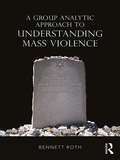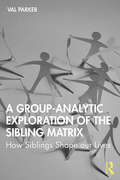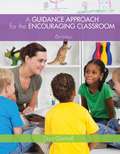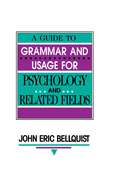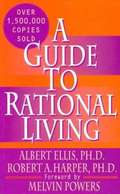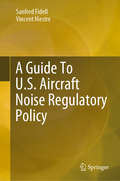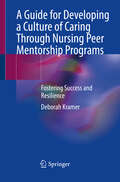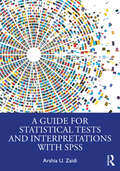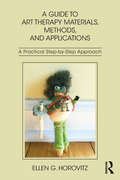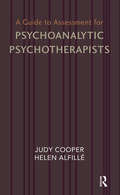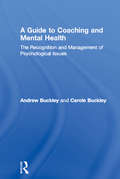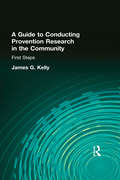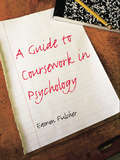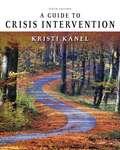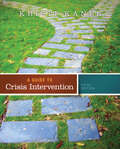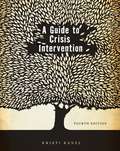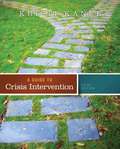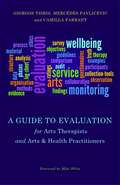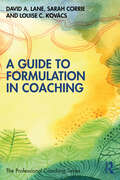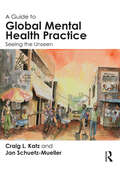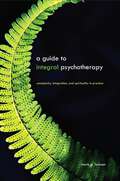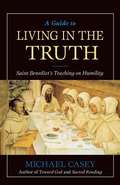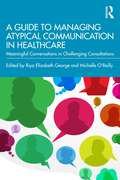- Table View
- List View
A Grief Out Of Season: When Your Parents Divorce In Your Adult Years
by Noelle Fintushel Nancy HillardFrom the book: "This book is divided in two parts. Part I, "A Map of the Terrain," lays the groundwork, seeking to understand the underlying sources of the adult child's pain. Part II, "The Journey," focuses on the more practical issues that confront the adult child at each stage of development." The authors provided many case histories to illustrate their points. In writing this book, the author used research results, case material, and their experience in dealing with the effects of divorce on adult children. Not only is this book scholarly, it is also applicable to some readers.
A Group Analytic Approach to Understanding Mass Violence: The Holocaust, Group Hallucinosis and False Beliefs
by Bennett RothA Group Analytic Approach to Understanding Mass Violence makes an analytic examination of the enactment of genocide by Nazi Germany during World War II to explore how mass and state-sponsored violence can arise within societies and how the false beliefs that are used to justify such actions are propagated within society. Bennett Roth makes use of Bion’s concept of ‘Hallucinosis’ to describe the formation of false group beliefs that lead to murderous violence. Drawing on both group analysis and psychoanalysis, Roth explores in relation to genocide: how people form and identify with groups the role of family groups how conflict can arise and be managed how violence can arise and be justified by false beliefs how we can best understand these dysfunctional group dynamics to avoid such violence. A Group Analytic Approach to Understanding Mass Violence will be of great interest to all psychoanalysts and group analysts seeking to understand the role of false beliefs in their patients and society more generally. It will also be of interest to students and scholars of Holocaust studies programs or anyone seeking to understand the perpetration of genocide in the past and present.
A Group-Analytic Exploration of the Sibling Matrix: How Siblings Shape our Lives
by Val ParkerA Group-Analytic Exploration of the Sibling Matrix: How Siblings Shape our Lives offers a fresh approach to siblings, recognising how these relationships are embedded in the framework of the family and how sibling experiences shape our lives, influencing relationships with partners, friends and colleagues, and affecting how we take our place in groups and in society. The book is divided into three parts. Part One focuses on the sibling life cycle, exploring how these relationships shift and change throughout life according to context and circumstances. In Part Two, Parker uses clinical examples to consider how therapists working with individuals and groups might expand their thinking to incorporate the sibling matrix. The final part investigates how the sibling matrix manifests in organisational life and considers how we might develop mutuality and cooperation in our universal sibling matrix. Drawing on the author’s wealth of experience as a clinician, the book incorporates compelling personal stories and clinical examples to bring to life the realities and nuances, the good and bad, the healthy and supportive, and also the potentially damaging aspects of sibling relationships. Accessibly written, this is a rich and rewarding invitation to reflect on our own experience, whether as clinicians, researchers or as members of our own sibling matrix.
A Guidance Approach for the Encouraging Classroom
by Dan GartrellA GUIDANCE APPROACH FOR THE ENCOURAGING CLASSROOM, 5/E, is for students in two- and four-year early childhood programs as well as graduate courses. It easily can function as a primary text in classes that address group management, the learning environment, child guidance, child behavior, challenging behavior, conflict management, and peace education topics. The text addresses ages 3 - 8 years in three parts. Part 1 explores the foundation of guidance in early childhood education and covers key concepts such as conventional discipline versus guidance, mistaken behavior, the guidance tradition, and innovative theories about child development with guidance. Part 2 focuses on building and organizing an encouraging classroom, as well as providing key elements of an encouraging classroom, including daily schedule, routines, use of thematic instruction, importance of working with parents, and leadership communication. Part 3 addresses problem solving and challenging behavior in the encouraging classroom, including a practical illustration for how to use and teach conflict management and coverage of the five-finger-formula. The book also covers nontraditional families as well as the effects of societal violence in the classroom. Throughout, this experience-based resource includes real-life anecdotes that allow professionals to make the shift from conventional classroom to developmentally appropriate guidance.
A Guide To Grammar and Usage for Psychology and Related Fields
by John Eric BellquistWhy another book on this topic? The author's experience editing leading journals in psychology suggests that publication manuals and books on writing about experimentation in psychology do not adequately address grammatical usage and style. Much of the advice published for scientific writers reads as if it had been written either by English teachers for writers who do not publish in scientific fields, or by scientific writers who think that the information already available in countless handbooks on grammar and style for student writers in English classes is enough. Unfortunately, such traditional handbooks do not offer the particular sorts of commentary that scientific writers need. This book offers specific advice on a host of issues ranging from the appropriate use of abbreviations to wordiness -- and how to avoid it. Dr. Bellquist's expertise in both the English language and the language of scientific writing ideally positions him to offer guidelines on the use of the passive, the best wording for statistical presentations, and just how to describe experimental procedures, among many other topics. Complete with examples and principles to guide writing decisions, this book will assist both students and seasoned professionals in presenting their work clearly for maximum impact. This book is intended as a guide to grammar and usage for writers in scientific fields -- particularly in experimental psychology and all fields related to experimental psychology. Features of the book include: * alphabetical entries and numerous cross references on grammar, usage, and style; * numerous examples taken from scientific papers or based on actual cases; * discussions of semantic problems of grammar such as modification, predication, and statement; * and discussions of usage specific to experimental psychology, statistics, and related fields.
A Guide To Rational Living Third Edition
by Albert Ellis Robert A. HarperNew, Updated Third Edition of A Guide to Rational Living. . . An International Classic in the Field of Psychology By the creators of the most popular forms of therapy in the world: Cognitive Behavior Therapy (CT) and Rational Emotive Behavioral Therapy (REBT). Considered by Many to Be the Best Book On Psychotherapy Ever Written If you have the rigorous honesty necessary to conduct self-analysis, this book can be the most important one you have read. For although it makes no promises, it can help you more than all the other self-help books put together. Rational Emotive Behavioral Therapy can teach any intelligent person how to stop feeling miserable about practically anything. Direct, get-to-the-heart-of-the-problem methods teach you what you often do to needlessly upset yourself and what you can do, instead, to make yourself emotionally stronger. These practical, proven methods of changing your self-defeating emotions and behaviors reflect the authors' vast experience as therapists and as teachers of therapists from all over the world, and have been backed by literally hundreds of research studies. A Guide to Rational Living provides much sought-after answers for individuals with problems, and it can help everyone to feel better about themselves and to deal with their lives more effectively.
A Guide To U.S. Aircraft Noise Regulatory Policy (Springerbriefs In Applied Sciences And Technology Ser.)
by Sanford Fidell Vincent MestreAviation noise remains the primary hindrance to expansion of airport and airspace capacity in the United States. This book describes the development and practice of U.S. aircraft noise regulation, as well as the practical consequences of regulatory policy. Starting in the pre-jet transport era, the book traces the development of the modern framework for characterizing, standardizing, predicting, disclosing, and mitigating aircraft noise and its effects on airport-vicinity communities. Among other matters, the book treats noise-related consequences of the 1978 deregulation of the airline industry; prediction and mitigation of community reaction to airport noise; land use compatibility planning; recent research and industry trends; and some suggestions for potential improvements to current policy. Initial chapters describe the assumptions underlying aircraft noise regulation, and lay out the chronology of U.S. aircraft noise regulatory practice. Later chapters provide overviews of population-level effects of aviation noise, including health effects, speech and sleep interference, and annoyance. Readers will learn why predictions of the prevalence of aircraft noise-induced annoyance have systematically underestimated adverse community response to aircraft noise, and how such underestimation has complicated approval and funding of airport and airspace improvement projects. They will also learn why attempts at noise-compatible land use planning are seldom fully successful.
A Guide for Developing a Culture of Caring Through Nursing Peer Mentorship Programs: Fostering Success and Resilience
by Deborah KramerThis book describes in detail how to develop successful programs of nursing mentorship, utilizing concepts of caring that yields a strong, caring body of nurses who will be “nurse thrivers” as they find fulfilment and meaning in their professional commitment and will train others to do the same. The mentorship program is the ticket to success that many students need to complete their degree program, prevent burnout, pass the nursing NCLEX examination, and remain in the workforce after graduation. The current attrition rate in baccalaureate nursing programs is 25-50%, as is the attrition rate in the first 2 years of employment of new RN's entering the workforce. Burnout is due to a lack of care and support for helping the students navigate the rigor and demands of the nursing program. Creating a community of learners with caring and support creates an environment that fosters academic engagement and success. The unique aspect of this book is its focus on creating a caring environment to support the students; helping them develop caring skills, empathy, resilience and their own self-care; developing the skills for success beyond their educational process into the workforce. This book integrates all patterns of knowing - personal, aesthetic, empiric and ethical - and provides the missing link of peer mentorship necessary to the development of resilient, emancipated nursing students and graduates capable of working in community with others to establish cultures of care in health care. This is a must have resource for transformation of nursing education in the next century! Foreword by Dr. Margaret McClure.
A Guide for Statistical Tests and Interpretations with SPSS
by Arshia U. ZaidiA Guide for Statistical Tests and Interpretations with SPSS is designed for students taking basic and advanced courses in statistics, taking an integrative and practical approach to learning statistics. It guides students through navigating SPSS outputs and writing quantitatively, dealing with technical and substantive interpretations without resorting to complex mathematical formulae.Starting from the basics of quantitative research methods and discussing descriptive and inferential statistical tests, this book provides a unique perspective of data analysis with SPSS. It makes a conscious effort to explore the various statistical methods one can use to dissect a data set using basic or advanced statistical techniques to achieve the best outcome. It covers the practical questions that arise while doing an assignment, final paper, or thesis – showing students how to proceed to the next step in their interpretation and analysis. It will provide quantitative methodology or data analysis students with core interpretations of SPSS outputs for key statistical tests. It will also demonstrate how to select and report the key trends and patterns of the data using descriptive and inferential statistics, the requirements and/or assumptions of each test, as well as the precise language to use for reporting on each test.With SPSS screenshots and step-by-step advice, this book will be useful for all undergraduate and graduate students in the social sciences and humanities, as a supplemental textbook to provide practical guidance on moving through all steps of statistical testing and analysis.
A Guide for the Statistically Perplexed
by David L. Streiner Canadian Psychiatric AssociationDo statistics-heavy research papers give you a headache? Are you baffled by bias, confused by correlation, or flummoxed by F-tests? A Guide for the Statistically Perplexed is here to help! This book is designed to assist students, clinicians, and researchers in becoming familiar with statistical and research techniques by covering the essentials of the topic and drawing attention to many common problem areas.Inspired to write on this topic in reaction to mistakes he encountered in actual papers, David L. Streiner uses his trademark sense of humour and light-hearted style to explain complex statistical concepts in lucid, jargon-free language. Streiner delves into topics such as presenting data (or, conversely, how not to), statistical techniques, and more advanced procedures. To help readers detect problems with research design and interpretation, he details important 'CRAP' (convoluted reasoning or anti-intellectual pomposity) detectors for which they should watch out.Even those with little or no background in statistics, measurement theory, or research will come out of A Guide for the Statistically Perplexed with a new understanding and appreciation of these topics.
A Guide to Art Therapy Materials, Methods, and Applications: A Practical Step-by-Step Approach
by Ellen G. HorovitzWritten by a well-respected author and practitioner in the field of art therapy, A Guide to Art Therapy Materials, Methods, and Applications is an innovative, comprehensive text that guides readers in how to use basic to advanced art materials and methods in a wide range of clinical settings. Through the lens of both developmental stages and assessment, the book offers practical, step-by-step instructions to incorporate these materials and methods into therapeutic work with clients of all ages and populations. In addition to such classic tools as drawing, paints, pastels, and clay, coverage of materials and special topics extends beyond the existing literature to include glass, knitting, quilting, wood burning, felting, digital applications, phototherapy, byproducts, and more. Unlike previous guides, this book specifies population benefits and contraindications for each material and technique. This research-based guide for using art materials in a safe and effective manner will be a welcome resource for students, seasoned art therapists, and mental health counselors.
A Guide to Assessment for Psychoanalytic Psychotherapists
by Judy Cooper Helen AlfillePsychoanalytic psychotherapists and psychoanalysts inevitably find themselves doing assessment in their work, both in private practice and in a clinical setting such as the NHS. The authors felt a need for a book that covers this vital aspect of their work, which would be of benefit both to students in training and to practitioners. Amongst subjects covered are the nature of assessments, the setting, consultation, contraindications, and clinical examples. This title contains the distilled wisdom of over twenty years experience in the field.
A Guide to Coaching and Mental Health: The Recognition and Management of Psychological Issues (Essential Coaching Skills And Knowledge Ser.)
by Andrew Buckley Carole BuckleyIt is vital that coaches have the ability to recognise mental health problems in their clients, enabling them to make an informed decision about whether coaching is appropriate. A Guide to Coaching and Mental Health provides an indispensable introduction to the assessment of psychological issues in the context of coaching. Divided into three sections, the book covers all the legal, ethical and practical considerations. Section one, Working on the Boundary, starts by exploring the distinction between normal and abnormal behaviour. In section two, What’s Being Said, the authors introduce fictional case studies, which cover a range of possible mental health issues from mild depression and anxiety, through to psychoses and potentially life threatening problems. Section three, Categories of Mental Illness, guides the reader through the definition and management of the more common mental health problems. This accessible and jargon-free guide to identifying mental illness will prove invaluable for coaches and other related professionals, whatever their level of experience.
A Guide to Conducting Prevention Research in the Community: First Steps
by James G KellyThis provocative and useful volume is a step-by-step guide to assist professionals in implementing valid and useful community research and creating preventive interventions that have positive and lasting effects on the development of the community. The authors--including James G. Kelly, one of the fathers of prevention--offer valuable suggestions for developing community processes to assist the prevention researcher and the community in designing research that is embedded in the community. Experts focus on the topics that can help establish and sustain effective long-term working relationships with community members. Numerous examples illustrate how the collaborative working relationship can create the variety of resources that are needed to eventually implement policy changes stimulated by the research and help to sustain the impact of the research findings after the research has been completed.This exciting book illustrates how community research related to the prevention of mental illness and the promotion of mental health can be scientific and objective, as well as a positive collaboration between the research staff and community members. Focus upon community needs Emphasize educational activities to support the prevention research Identify points of policy impact before the research begins Enhance the development of social networks and social support systems for the development of competencies Provide criteria for the selection of systemic variables for the research Include reference to the multiple levels of a community which may affect the research topic Specify ways in which participants can identify and own the research topic Outline criteria for assessing the side effects of the prevention research In order to better understand the needs, values, commitments, and resources of the community in which he or she is working, the researcher is encouraged to select research topics derived from underlying community needs, educated the public about prevention, identify points of policy impact, and determine the informal social networks that enhance the development of social competencies in the community. The benefits of the collaborative relationship between prevention researchers and the community are strongly emphasized. A Guide to Conducting Prevention Research in the Community aims to guide citizens and professionals in implementing valid and useful community research and create preventive interventions that have positive and lasting effects on the development of the community.
A Guide to Coursework in Psychology
by Eamon FulcherEver had difficulty choosing a research project? Ever wondered how your work will be marked? This book will help students to understand the coursework specifications and marking criteria for a number of key exam boards, including; AQA (specification A and B), OCR, EDEXCEL and SQA. It provides specific and highly relevant advice on how to maximise achievement in coursework. Guidance is offered on how best to choose a research project, through to practical advice on how to carry out research and write up reports. Topics to be avoided are also considered and advice on how to navigate the difficulties and avoid common pitfalls provided. Key issues covered include: * An overview of the main methods of investigation in psychology * Data analysis, including how to present data in Word and Excel and how best to comment on it * How to draw conclusions from data and create inferential statistics. Incorporating a series of examples, including an investigation from start to finish, and a laboratory experiment, this book provides clear, hands-on advice. It will be an invaluable tool for GCSE, AS and A2 students, helping them to maintain their motivation through coursework assignments and to achieve their potential.
A Guide to Crisis Intervention
by Kristi KanelThis book is written for college students and beginning mental health professionals who might benefit from a step-by-step practical guide on how to work effectively with clients in a variety of settings. There are many case examples and practice opportunities woven throughout the text. This text works great in courses in which students are given opportunities to practice what they are reading through role-plays with one another, or with actual clients, under the supervision of the instructor or other mental health counselors and also useful for professionals such as police, firefighters, military personnel, as well as mental health counselors.
A Guide to Crisis Intervention
by Kristi KanelThis fifth edition of Dr. Kristi Kanel's A GUIDE TO CRISIS INTERVENTION covers the fundamentals of situational and developmental crises, how they occur, and how they have been managed since the 1940s. Kanel discusses traditional counseling models as they relate to crisis intervention, and shows how they have been incorporated into her model-the ABC Model of Crisis Intervention-that is used by both paraprofessionals and professionals. Presented in detail, the ABC Model of Crisis Intervention is ideal for use in any mental health setting and with any individual (from any population) in a crisis situation. The text provides detailed examples of specific crisis situations, including developmental crises, trauma crises, post traumatic stress disorder crises (PTSD), crises of personal victimization, substance abuse crises, and crises related to loss, terminal and serious illness, and disabilities. New chapters discuss veterans' issues; sexual assault and rape; and ethical, legal, and professional issues. The author also explores suicide assessment and the use of the Mental Status Exam. Every chapter offers case vignettes to aid students in practicing the skills presented in the ABC Model of Crisis Intervention.
A Guide to Crisis Intervention (4th edition)
by Kristi KanelWritten for beginning paraprofessional counselors, this textbook on crisis intervention outlines skills and strategies that Kanel (crisis intervention, California State U., Fullerton) found useful as a psychotherapist. She describes what can be defined as a crisis, the history of the field, ethical and professional issues, cultural sensitivity, and the ABC model of conducting mental health interviews with clients, which consists of three stages: developing and maintaining contact, identifying the problem and providing therapeutic interaction, and coping. She then outlines crises that are dangers, including suicide, self-mutilative behaviors, and psychotic breakdowns, and discusses gravely disabled mentally ill persons. Types of crises associated with stages of development, loss, AIDS and HIV, substance abuse, post-traumatic stress, disaster, and child, spousal, and sexual abuse are detailed. Indexes are divided by subject and name. Annotation ©2006 Book News, Inc., Portland, OR (booknews.com)
A Guide to Crisis Intervention (Fifth Edition)
by Kristi KanelThis practical nuts-and-bolts guide provides readers with the skills necessary to handle any crisis situation. The book utilizes the comprehensive ABC Model of Crisis Intervention, which can be used as effectively for day-to-day interactions as for emergency situations. A GUIDE TO CRISIS INTERVENTION, 5th Edition addresses such crises as drug abuse, secondary PTSD, crisis worker burnout, AIDS, suicide, death and dying, Alzheimer's, and victimization and abuse.
A Guide to Evaluation for Arts Therapists and Arts & Health Practitioners
by Mike White Mercedes Pavlicevic Camilla Farrant Giorgos TsirisEvaluation is crucial to the development and sustainability of Arts Therapy and Arts & Health practices. This guide supports practitioners in their quest to integrate thorough evaluation procedures in their everyday practices by providing practical guidance for designing, planning and implementing bespoke evaluation projects. Based on the authors' experience of designing and realising evaluation projects and running training workshops, a range of suggestions are offered for developing appropriate timelines and collection tools, ensuring organisational diplomacy, and managing what can be a delicate balance of truth, fact and perception. This guide will help practitioners to evaluate their services and projects by taking into consideration the unique profile of the practice, the workplace, clients, project participants, and sectors.
A Guide to Formulation in Coaching (The Professional Coaching Series)
by Sarah Corrie David A. Lane Louise C. KovácsLane, Corrie and Kovács present a foundational text for coaches wishing to improve their coaching practice through use of formulation.A Guide to Formulation in Coaching examines the nature and purpose of formulation and how to develop effective formulations that can inform and improve practice. It combines theoretical perspectives with case studies illustrating its use in different coaching contexts to provide a comprehensive and accessible account of the purpose, perspectives and processes used in formulation. In addition to providing practice-based examples and drawing on the literature, the book provides a series of exercises to enable readers to refine their individual approaches.Practical and accessibly written, this book will be a valuable resource for coaches and coaching psychologists, coaching supervisors and trainers, and academics interested in understanding the role of formulation and how it applies in a coaching context.
A Guide to Global Mental Health Practice: Seeing the Unseen
by Craig L. Katz Jan Schuetz-MuellerDrawing on the authors’ experience in developing and implementing global mental health programs in crisis and development settings, A Guide to Global Mental Health Practice: Seeing the Unseen is designed for mental health, public health, and primary care professionals new to this emerging area. The guide is organized topically and divided into four sections that move from organizing and delivering global mental health services to clinical practice, and from various settings and populations likely to be encountered to special issues unique to global work. Case studies based around a central scene are threaded throughout the book to convey what global mental health work actually involves. Mental health professionals of all backgrounds, including social workers, nurses, nurse practitioners, psychologists, and psychiatrists, as well as public health professionals and community level medical professionals and mental health advocates will benefit from this engaging primer. It is the book for anyone committed to addressing mental health issues in a low resource or crisis-hit setting, whether international or domestic.
A Guide to Integral Psychotherapy: Complexity, Integration, and Spirituality in Practice (SUNY series in Integral Theory)
by Mark D. FormanThis book provides a practical introduction to Integral Psychotherapy, which positions itself as the most comprehensive approach to psychotherapy yet offered. Grounded in the work of theoretical psychologist and philosopher Ken Wilber, it organizes the key insights and interventions of pharmacological, psychodynamic, behavioral, cognitive, humanistic, existential, feminist, multicultural, somatic, and transpersonal approaches to psychotherapy. Integral Psychotherapy does not attempt to unify these diverse models, but rather takes a metatheoretical perspective, giving general guidelines for which is most appropriate in a wide range of clinical situations. It also strongly emphasizes the therapist's own personal development, under the premise that the depth and complexity of the human psyche must be understood first within the self if it is to be understood fully in others. This essential text is for therapists and others drawn to holistic approaches to psychotherapy, and serves as a theoretical ground and precise guide for those interested in applying the Integral model in therapeutic practice.
A Guide to Living in the Truth: Saint Benedict's Teaching on Humility
by Michael CaseyThis is a beautifully written devotional book for those who want a better understanding of the Biblical intentions of humility. It also explores Saint Benedict's encouragement of all religious disciples to practice the Christlike characteristic.
A Guide to Managing Atypical Communication in Healthcare: Meaningful Conversations in Challenging Consultations
by Michelle O’Reilly Riya Elizabeth GeorgeThis book presents a supportive and practical guide for healthcare professionals and trainees in a way that considers a wide spectrum of atypical communication conditions, their impact on everyday healthcare interactions, and the social and cultural contexts in which interactions with atypical communicators take place. A growing number of patients have been reporting atypical capacity for communication, creating unique challenges for healthcare professionals and patients in forming meaningful clinical interactions. In this book, leading international scholars from a range of healthcare professions provide insight into optimal management for those with atypical communication conditions. This includes speech, language, and hearing impairments. Chapters provide optimal management strategies, case examples, clinical recommendations, and recommended resources relevant for a range of healthcare professionals. The first collection of its kind, this book supports inter-professional practices and serves as a useful guide for those with an interest in clinical communication, and communication and diversity. This book will be a valuable resource for health and mental healthcare professionals as well as undergraduate and postgraduate students in healthcare and allied healthcare courses. It can be included as recommended reading material in clinical communication curricula.

